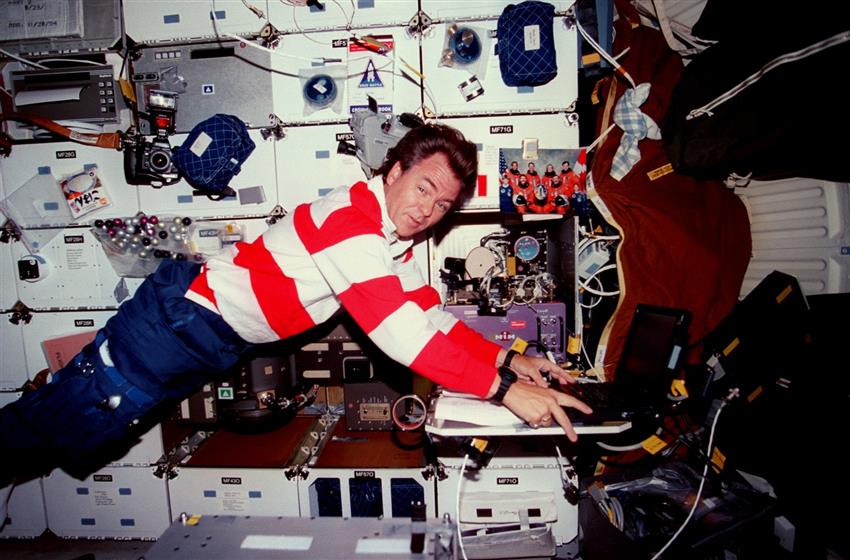Biography of Bjarni Tryggvason
Born:
From: Reykjavik, Iceland
Died:
Background: Meteorologist, researcher, lecturer
Education: Bachelor of Applied Science in engineering physics, postgraduate work in engineering with specialization in applied mathematics and fluid dynamics
Languages: English, Russian
Mission: STS-85
Personal data: Born , in Reykjavik, Iceland, Bjarni Tryggvason had two children. He enjoyed jogging, skiing, and general fitness.
He was an Airline Transport rated pilot with more than 4,500 hours of flight experience, and 1,800 hours as a flight instructor. Mr. Tryggvason was active in aerobatic flight and completed a Captaincy check in the Tutor jet trainer with the Canadian Air Force. He enjoyed jogging, skiing, and general fitness.
Education: Attended primary school in Nova Scotia and British Columbia and high school in Richmond, British Columbia. Obtained a Bachelor of Applied Science in engineering physics from the University of British Columbia in . Completed postgraduate work in engineering with specialization in applied mathematics and fluid dynamics at the University of Western Ontario (currently Western University).
Affiliations: Member of the Canadian Aeronautics and Space Institute.
Special honours: NASA Space Flight Medal (); Doctor of Science (honoris causa), Western University (); Doctorate of Philosophy (honoris causa), University of Iceland (); Order of the Falcon from Iceland (); three Canadian Space Agency Innovators Awards (); several scholarships.
Experience: Bjarni Tryggvason was a meteorologist with the cloud physics group at the Atmospheric Environment Service (currently the Meteorological Service of Canada) in Toronto in and . After that, he served as a research associate in industrial aerodynamics at the Boundary Layer Wind Tunnel Laboratory at Western University from to .
Mr. Tryggvason was a guest research associate at Kyoto University in Kyoto, Japan, in , and at James Cook University in Townsville, Australia, in . He was a lecturer in applied mathematics at Western University from to .
From to , Mr. Tryggvason was a research officer at the Low Speed Aerodynamics Laboratory at the National Research Council Canada and was a lecturer at the University of Ottawa and at Carleton University from to .
He wrote more than 50 published papers and held three patents.
Astronaut Experience: Selected as one of the original six Canadian astronauts in , Mr. Tryggvason trained as a backup payload specialist for the CANEX-2 set of experiments, which flew on Mission STS-52 in . He was also the project engineer for the Space Vision System Target Spacecraft, which was deployed during that mission.
Mr. Tryggvason also served as the principal investigator for the following projects: the development of the Large Motion Isolation Mount (LMIM), which flew numerous times on NASA KC-135 and DC-9 aircraft; the Microgravity vibration Isolation Mount (MIM), which operated on the Russian space station, Mir, from until to support several Canadian and US experiments in material science and fluid physics; and the MIM-2, which flew on STS-85 in . He was the originator and technical director during the early development phase of the Microgravity Vibration Isolation Subsystem (MVIS), which the Canadian Space Agency (CSA) developed for the European Space Agency Fluid Science Laboratory.
On , Mr. Tryggvason flew as a payload specialist aboard Space Shuttle Discovery on Mission STS-85. His primary role was to test MIM-2 and perform fluid science experiments designed to examine sensitivity to spacecraft vibrations, in order to develop a better understanding of the need for systems such as the MIM on the International Space Station (ISS), and to study the effect vibrations have on the many experiments performed on the ISS.
In , he was invited to take part in NASA mission specialist training held at the Johnson Space Center in Houston, Texas. His class underwent two years of physical and academic training, and marked the first group of astronauts to be trained as both mission specialists for the space shuttle and as potential crewmembers for the ISS.
After he completed mission specialist training, his NASA duties included serving as a crew representative for the Shuttle Avionics Integration Laboratory, which is used to test shuttle flight software prior to onboard use. He also supported integrated simulations on the ISS Training Facility at the Johnson Space Center, and served as a CSA representative on the NASA Microgravity Measurement Working Group and on the ISS Microgravity Analytic Integration Team.
From to he worked in the private sector while on leave from the CSA. He returned temporarily to work at the CSA in and held the position of visiting professor at Western University.
Bjarni Tryggvason passed away at the age of 76.



